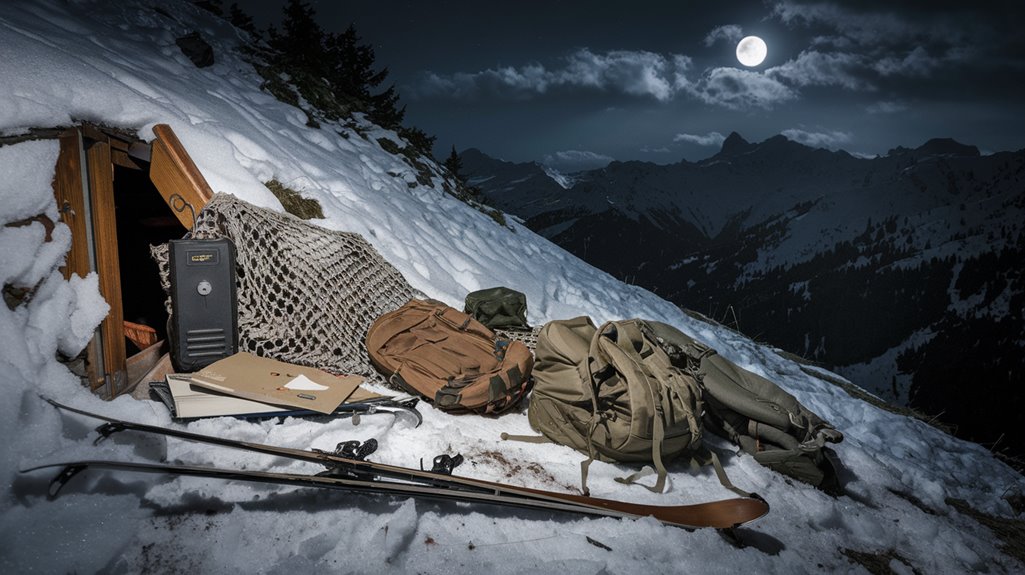Operation Greenup: The Mission Behind Inglourious Basterds
You've probably watched "Inglourious Basterds" and marveled at its audacious take on World War II, but the real story behind it is even more fascinating. Operation Greenup, a covert mission led by Jewish operatives in Nazi-controlled Austria, didn't just change the course of the war – it revolutionized modern intelligence gathering. While Tarantino's film takes creative liberties, the true tale of courage, strategy, and unlikely alliances in the snow-covered Tyrol region proves that sometimes reality outshines fiction.
The Real-Life Heroes of Operation Greenup

While Quentin Tarantino's "Inglourious Basterds" captured audiences with its fictional World War II revenge tale, the real-life Operation Greenup featured equally compelling heroes who risked everything for the Allied cause.
The three courageous operatives who led this remarkable mission came from diverse backgrounds. Fred Mayer, a German-born Jew who'd been initially rejected by the U.S. Army, became the team's leader thanks to his linguistic abilities. The team parachuted into Austria, landing at 10,000 feet on a treacherous glacier ridge to begin their mission. Their incredible story was later showcased in the documentary The Real Inglorious Bastards.
Hans Wijnberg, a Dutch Jew who'd lost his family to Auschwitz, served as the team's essential radio operator.
Franz Weber, a former Wehrmacht officer who'd chosen to desert, rounded out this unlikely trio. Together, they formed an extraordinary intelligence gathering unit that would go on to save countless lives through their daring work behind enemy lines in Austria's Alpine region.
Behind Enemy Lines: Mission Planning and Execution
The audacious heroes of Operation Greenup faced a mission that would test every ounce of their resolve and ingenuity. Their mission objectives focused on gathering intelligence about German movements across the Brenner Pass, but they'd have to overcome formidable odds – most OSS missions ended in failure, with capture and torture by the Gestapo a constant threat. The team conducted many of their operations under the cover of night combat to maximize their chances of success.
The team's infiltration strategies were as bold as they were dangerous. You'd marvel at their courage: dropping from just 300 feet above a frozen lake to avoid radar detection, with Mayer later infiltrating officer barracks while Wijnberg managed critical communications. The mission took flight when Lieutenant John Billings volunteered to pilot their dangerous insertion despite widespread skepticism from top officers.
They relied on deception, false identities, and local collaborators like Weber to gather intelligence on troop and ammunition movements. Each step required precise execution, with no room for error.
The Strategic Importance of the Tyrol Region
Nestled between Austria and Italy, this mountainous region became one of World War II's most critical strategic prizes.
You'll find the Tyrol's geopolitical significance dates back centuries, when the Habsburg Empire recognized its value in controlling the crucial Brenner Pass, a gateway between northern and southern Europe.
The region's complex history of cultural tensions stems from its mixed German and Italian-speaking populations, making it a frequent flashpoint in European conflicts.
You can trace its strategic importance through the Napoleonic Wars, World War I, and ultimately to Operation Greenup during WWII.
The OSS division directed intelligence operations in the region from their base in Bari, Italy.
While the Allies valued the Tyrol's military advantage, they couldn't ignore its deeper significance as a cultural crossroads.
This unique blend of strategic location and cultural complexity made the Tyrol an irresistible target for military planners and political strategists alike.
After World War I, the Treaty of Saint-Germain officially transferred South Tyrol to Italian control, fundamentally altering the region's political landscape.
A Bloodless Victory: The Liberation of Innsbruck
Building on the Tyrol's strategic significance, Operation Greenup's crowning achievement unfolded in Innsbruck during the final months of World War II.
You'll find that Fred Mayer's essential negotiations with Gauleiter Franz Hofer on May 2-3, 1945, led to a bloodless surrender that saved countless lives and preserved the historic city.
Despite enduring torture after his April 20 arrest, Mayer convinced Hofer to declare Innsbruck an open city, ensuring a peaceful changeover. This success was made possible through the crucial support of local resistance fighters who occupied key facilities after Nazi officials fled.
When the 103rd Infantry Division's tanks rolled in on May 3, they encountered no resistance. Instead, you'd have witnessed an extraordinary sight: forced laborers, POWs, and locals welcoming American soldiers with celebration.
Under Karl Gruber's leadership, regime opponents seized control, marking a seamless transfer of power that spared Innsbruck from becoming a battleground.
From History to Hollywood: Inspiring Tarantino's Vision

While Operation Greenup's real-life heroics unfolded in wartime Austria, its spirit of Jewish resistance and covert operations would later influence Quentin Tarantino's "Inglourious Basterds."
The legendary mission of Fred Mayer's infiltration as a German Army officer living among Nazi troops showcased the kind of audacious deception that would inspire future storytellers.
You'll find striking parallels between the OSS mission's daring infiltration of Nazi territory and Tarantino's fictional narrative, though he crafted his story through a different lens.
Among Tarantino's influences, the concept of Jewish soldiers penetrating enemy lines resonated deeply with his vision.
After years of development, starting even before "Kill Bill," he transformed what began as a straightforward men-on-a-mission film into a complex revenge fantasy.
His research, including visits to Normandy, helped shape the film's historical authenticity while maintaining creative freedom.
The film's production at Babelsberg studios added historical gravitas to the project, given the facility's expertise in period pieces.
Though not directly adapting Operation Greenup, Tarantino's cinematic adaptation captured the essence of wartime resistance through his unique storytelling approach.
 skilled radio operator Hans Wijnberg maintained vital communications throughout the mission, ensuring intelligence reached Allied forces.
skilled radio operator Hans Wijnberg maintained vital communications throughout the mission, ensuring intelligence reached Allied forces.
This mission exemplified how the Allies' SIGINT capabilities had transformed, allowing them to intercept thousands of German signals daily.
The peaceful surrender of Innsbruck was among Operation Greenup's most significant achievements, demonstrating how intelligence operations could prevent unnecessary bloodshed.
The operation's success, combined with other intelligence initiatives like Ultra and Enigma decryption, didn't just aid military strategy – it fundamentally changed how modern warfare would be conducted through sophisticated intelligence gathering and analysis.










